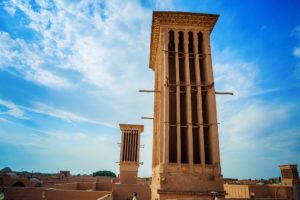[vc_row][vc_column width=”1/1″][vc_column_text]
 How wind towers have been used to create natural ventilation and passive cooling in buildings throughout North Africa and West Asia for centuries
How wind towers have been used to create natural ventilation and passive cooling in buildings throughout North Africa and West Asia for centuries
-
Origins
-
How it’s engineered
-
Designs & uses
-
Wind tower disadvantage(s)
-
Modern use/upgrade
One of the most unique ancient cooling systems is the windcatcher, or wind tower. The “windcatcher” moniker comes from their ability to catch passing winds and drive them down into buildings below.
This traditional architectural element was the natural air cooling system before the air conditioner existed. Though it functions pretty much like modern air conditioning system, it’s design is wildly different than the ACs we’re familiar with today.
One reason for the difference is because these natural ventilation systems were popularized in North Africa and West Asia. Californians might not be surrounded by harsh desert conditions, but places that are characterized by a hot and dry climate (such as North Africa and West Asia) have benefited from the natural air conditioning created by these high towers.[/vc_column_text][vc_column_text]
THE ORIGIN OF THE WIND CATCHER
[/vc_column_text][vc_column_text]
From ancient Persians and Egyptians to Babylonians and Arabs, civilizations have strived to adapt their architecture to the harsh, hot climates of their environments by developing natural ventilation methods.
TL;DR: Nobody knows for sure and the dispute between Iran and Egypt is still going as strong as the desert winds.
Paintings dating to around 1300BC discovered near modern-day Luxor depict two triangular structures above Pharaoh Nebamun’s royal residence, leading Egyptian archaeologists to believe the first wind catcher was developed in Egypt.
Meanwhile, ruins of a Persian fire temple dating to 4000BC feature numerous chimney-like structures, some of which have no trace of ashes, leading Iranian architects to postulate that wind catchers originated in Iran.[/vc_column_text][vc_column_text]
ENGINEERING SPECS OF THE WINDCATCHER
[/vc_column_text][vc_column_text]
In short, windcatchers provide passive ventilation for indoor spaces. They can also facilitate evaporative cooling with the help of water reservoirs inside buildings. Sometimes, they are pointed into the wind to catch more air. In other cases, they face away from potential sandstorms.
In general, the windcatcher functions on these several principles:
-
First, a windcatcher is capped and has several directional ports at the top (traditionally four). By closing all but the one facing away from the incoming wind, air is drawn upwards using the Coanda effect, similar to how opening one facing the wind would push air down the shaft. This generates significant cooling ventilation within the structure below, but is not enough to bring the temperature below ambient alone — it would simply draw hot air in through any cracks or windows in the structure below.
-
Therefore, the key to generating frigid temperatures seems to be that there are very few cracks at the base of the thick structure below, but there is a significant air gap above the qanat (a water management system used to provide a reliable supply of water to human settlements or for irrigation in hot, arid and semi-arid climates).
-
A qanat has quite a lot of water inside, because there are frequent well-like reservoirs along its path.
-
Completely shaded from the sun, a qanat also aggregates the cold, sinking air of the night, which is then trapped within, unable to rise up to the less dense surface air.
-
-
A windcatcher, however, can create a pressure gradient which sucks at least a small amount of air upwards through a house. This cool, dry night air, being pulled over a long passage of water, evaporates some of it and is cooled down further.
-
Finally, in a windless environment or waterless house, a windcatcher functions as a Solar or thermal chimney that uses convection of air heated by passive solar energy. It creates a pressure gradient which allows less dense hot air to travel upwards and escape out the top. This is also compounded significantly by the day-night cycle mentioned above, trapping cool air below. The temperature in such an environment can’t drop below the nightly low temperature.
Related reading(s): Windcatchers of Dubai: Traditional Cooling Towers Shape Desert Vernacular; Wind Towers Catch the Breezes (Mid East)[/vc_column_text][vc_column_text]
DESIGNS, LOCATION, EFFECTIVENESS
[/vc_column_text][vc_column_text]
Windcatchers are tall, chimney-like structures that protrude from the rooftops of older houses across North Africa and West Asia.
In their simplest form, wind catchers harness the cool breezes and redirect them downwards either into the home or into underground storage rooms to refrigerate perishable foods.
Studies have shown that wind catchers can reduce indoor temperatures by around 10 degrees. But since wind catchers are located at the highest point of a building, they are especially susceptible to deterioration and decay.
Related reading(s): An ancient engineering feat that harnessed the wind
Windcatchers vary in shape depending on the location, direction of the wind in the area, and surrounding geography.
Places that are surrounded by mountains means that desert winds are blocked so wind towers can be designed with different shapes and more inlets. In one particular place, the residential buildings of Yazd in Iran, most of the windcatchers are rectangular in shape, with inlets on each of the four sides to catch wind blowing from multiple directions. However, hexagonal and octagonal wind catchers are also common in that area.
Some wind catchers are multi-directional if the area has winds coming from all directions. In other places, wind catchers would have only one inlet to prevent harsh, dusty, desert winds from entering the houses.
Even in the absence of a breeze, wind catchers work as solar chimneys.
Windcatchers are so effective that they are routinely used as a refrigerating device, in the form of ice houses in many parts in Iran. Many traditional water reservoirs (ab anbars) are built with wind catchers that are capable of storing water at near freezing temperatures for months in summer.
They create a pressure gradient that pushes warm air up and out through the tower, leaving the interior of the home feeling cooler than the exterior. Often the cool air from the wind catcher passes through an alcove in a room on the ground level, down through a vent into the zir-zamin (basement), where perishable goods are stored.
Related reading(s): The Wind Catchers of Iran
[/vc_column_text][vc_column_text]
CONS OF WIND TOWERS
[/vc_column_text][vc_column_text]
However, conventional and traditional wind towers have several limitations. Some of these limitations are:
-
They allow small birds and insects to enter the building.
-
The head of wind towers is fixed and cannot rotate in the direction of the maximum ambient air.
-
A part of inlet air flow exit without circulating in the building.
- They do not have any application in regions with very low wind speed-high erosion against rain, wind and sun.
- Installation limitations and the number of wind towers that can be used in one building.
[/vc_column_text][vc_column_text]
WIND TOWERS AND MODERN USE
[/vc_column_text][vc_column_text]
In today’s world, the significance of energy and energy conservation is a common knowledge. It’s no surprise, then, that engineers are now looking at this functional architecture as a way of providing zero-energy cooling for contemporary buildings, not just in the Arab peninsula but around the world. Wind towers can save the electrical energy used to provide thermal comfort during the warm months of the year, especially during the peak hours.
Conventional and traditional wind towers are categorized into four general types:
-
One-sided wind towers where the air openings of this type of wind towers are only open in the desired direction of the wind. There is no opening in other directions.
-
Two-sided wind towers where, from architectural point of view, are simple and rather small wind towers. In comparison with the one-sided wind towers, the two-sided ones are more efficient for circulating airflow and have better performance. This type of wind tower has two roles: blowing and sucking airflow into the building.
-
Four, six, eight-sided wind towers that are bigger and also usually taller than the previous two types. The height and the structure of each opening depend directly on the climate of the region the wind tower is used in.
-
Cylindrical wind towers that are the most advanced type of wind towers with better performance than the other three types of wind towers previously described.
A new design for wind towers has been proposed where the wind towers are installed on top of the buildings, in the direction of the maximum wind speed in the region. If the desired wind speed is accessible in several directions, additional wind towers can be installed in several positions.
-
The proposed wind tower can also rotate and set itself in the direction of the maximum wind speed
-
A one-sided wind tower can be installed in another part of the building in the opposite direction in the regions where the wind speed is low, to improve the efficiency of the system a solar chimney
-
Transparent materials can be used in the manufacturing of the proposed wind towers to improve the use of natural light inside the building
Related reading(s): A new design of wind tower for passive ventilation in buildings to reduce energy consumption in windy regions; Can wind towers take the heat off UAE’s air-con addiction?
[/vc_column_text][/vc_column][/vc_row]


